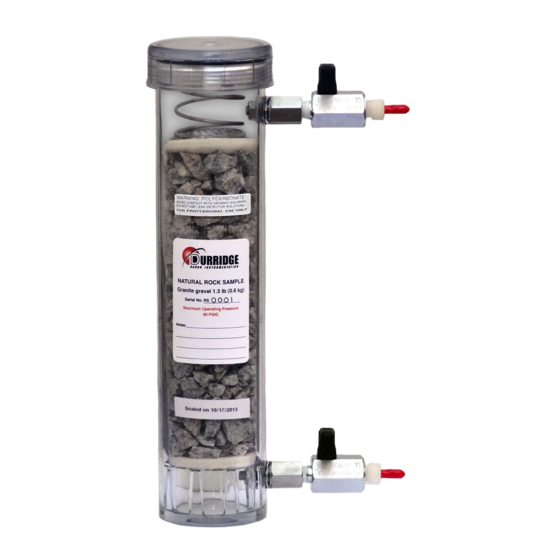DURRIDGE NATURAL ROCK SAMPLE User Manual - Page 13
Browse online or download pdf User Manual for Measuring Instruments DURRIDGE NATURAL ROCK SAMPLE. DURRIDGE NATURAL ROCK SAMPLE 14 pages. Performance monitoring accessory for the rad7

3.3.1 Experimental Protocol
a) Set up the experiment exactly as in the diagram above, or else with the RAD7 sampling path in
exactly the same setup as will be used for measuring thoron.
b) Adjust the flow rate through the Natural Rock Sample to 0.55 L/min. A flow rate of 0.55 L/min is
chosen as a standard flow rate for injecting thoron into the RAD7 sample path because that may be
relied upon to be less than the RAD7 pump flow rate, which may range from 0.6 L/min to 1 L/min or
higher. With the set up as shown in the diagram above, run the external pump and adjust the needle
valve so that the air flowing through the Natural Rock Sample is 0.55 L/min.
c) Move the flow meter to the RAD7 outlet. Remove the flow meter from its position between the
needle valve and the Natural Rock Sample and reconnect the tubing so that the needle valve is
connected directly to the Natural Rock Sample. Connect RAD7 outlet to the input of the flow meter.
The external pump can be kept running during this maneuver.
d) Change the RAD7 to thoron protocol. Use the default thoron protocol (
Thoron,[ENTER]
), or choose the default and then change individual parameters (e.g. cycle time) as
desired. Turn off the RAD7, turn on the printer, turn on the RAD7 and let it print out a header.
Examine the header to make sure everything is OK.
Test, Start, [ENTER].
e) Start a reading:
3.3.2 Calculation
With an identical air flow rate (0.55 L/min) through the Natural Rock Sample and identical tubing
attached to the T connector, for every thoron calibration check, the rate of injection of thoron into the
sample flow will always be the same. Let this be Th. The units of Th are pCi per minute or Bq per
minute.
If the RAD7 flow rate, measured at the RAD7 outlet, is V L/min, then the thoron concentration in the
sample air flow at the sampling point (which is very close to the T connection) will be Th/V. If Th is
expressed in pCi/min and V is in L/min then Th/V will be pCi/L. If Th is expressed in Bq/min and the
flow is in L/min then Th/V will be Bq/L. To convert to Bq/m
3.3.3 Assessing The Thoron Data
For an uncalibrated Natural Rock Sample, note the average thoron reading and the RAD7 flow rate.
Multiply the thoron reading by the flow rate to get Th, the rate of injection of thoron into the sample
flow (for units of Bq/m
and L/min, divide the product by 1,000 to get Bq/min). The experiment may
3
be repeated as often as desired; there is no need to wait for any ingrowth. However, after conducting
this experiment, the Natural Rock Sample must be left sealed for a month before a radon check may be
performed. The obvious time to do this experiment is 1 - 2 hours after a radon check.
As an option, DURRIDGE Company will calibrate a Natural Rock Sample for thoron. With a setup as
above and a flow rate of 0.55 L/min through the Natural Rock Sample, we give you the rate of injection
of thoron into the RAD7 sample path. You may then divide that by the flow rate of the target RAD7 to
obtain the thoron concentration at the sampling point. This may be compared with the thoron reading
in the RAD7 and a correction factor derived.
Records of the radon and thoron readings should be kept safely for later reference and comparison.
Sec$on 3
RAD7 Thoron Sensitivity Check
Setup, Protocol,
multiply by 1000.
3
13
